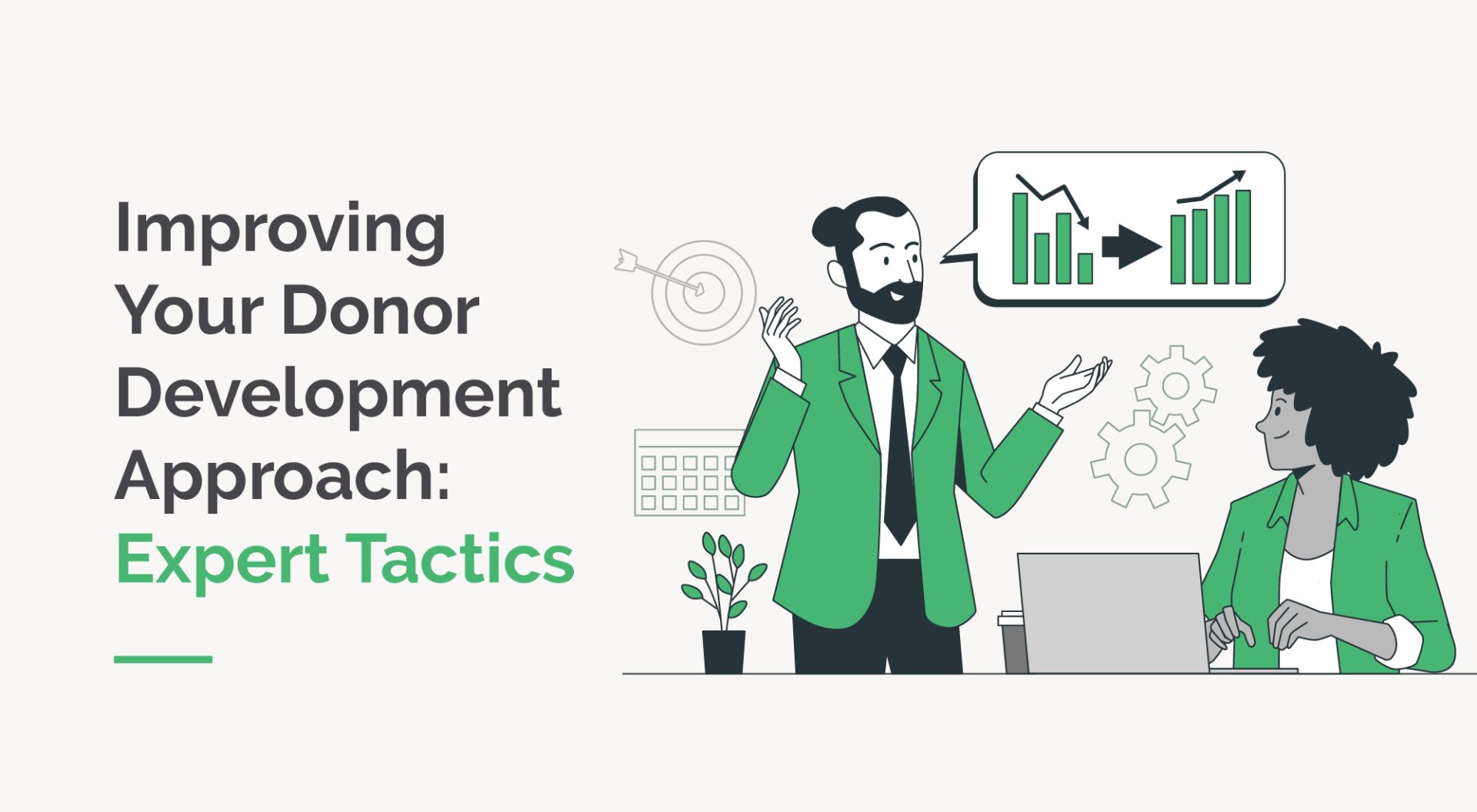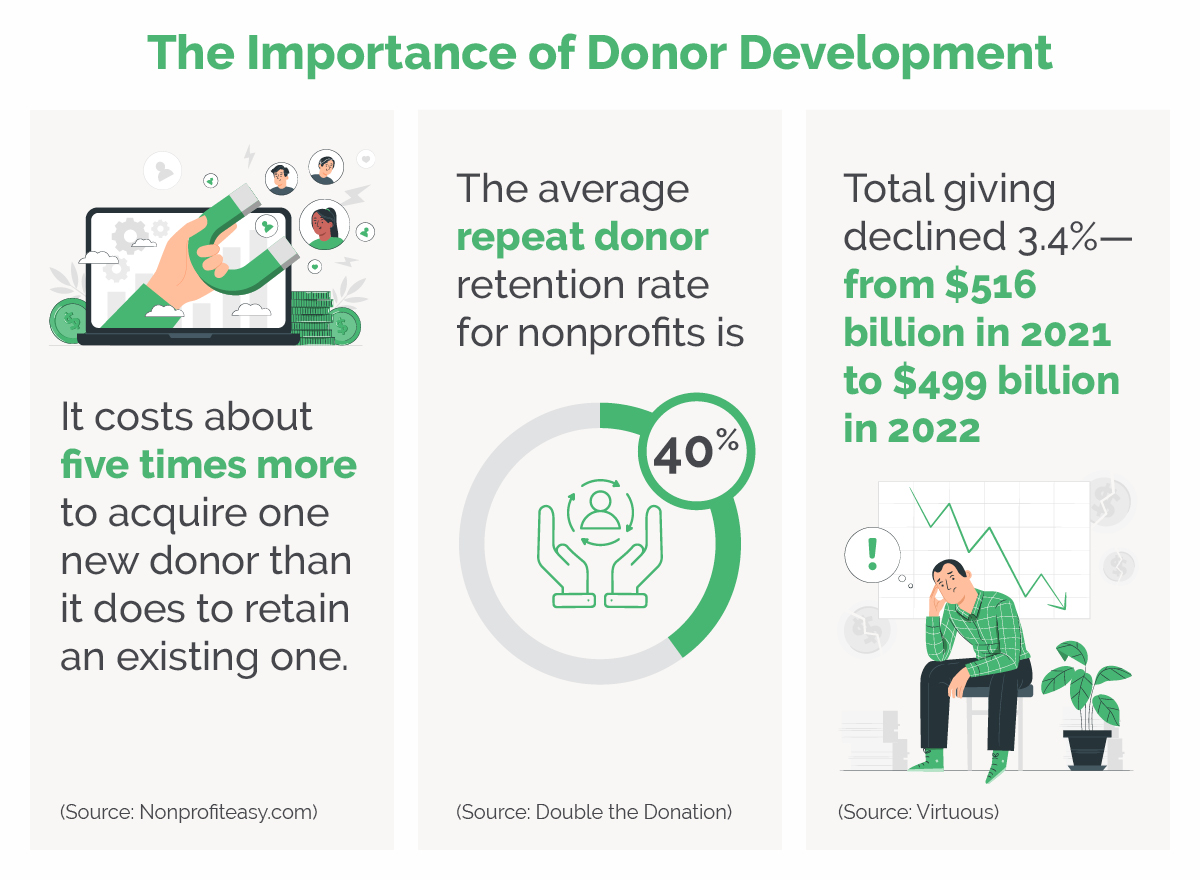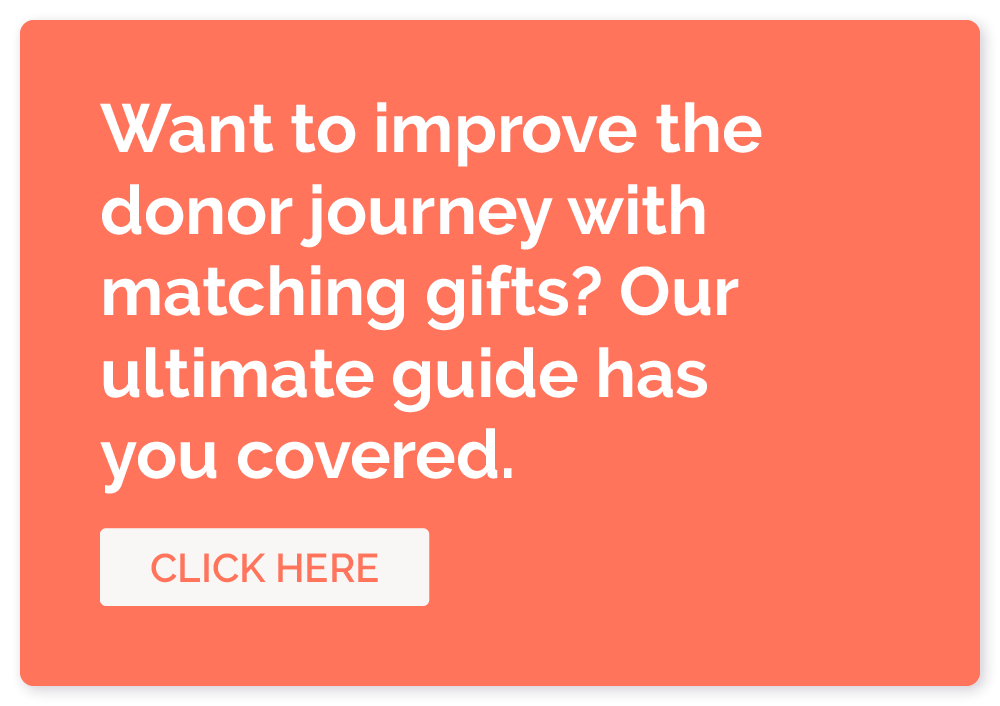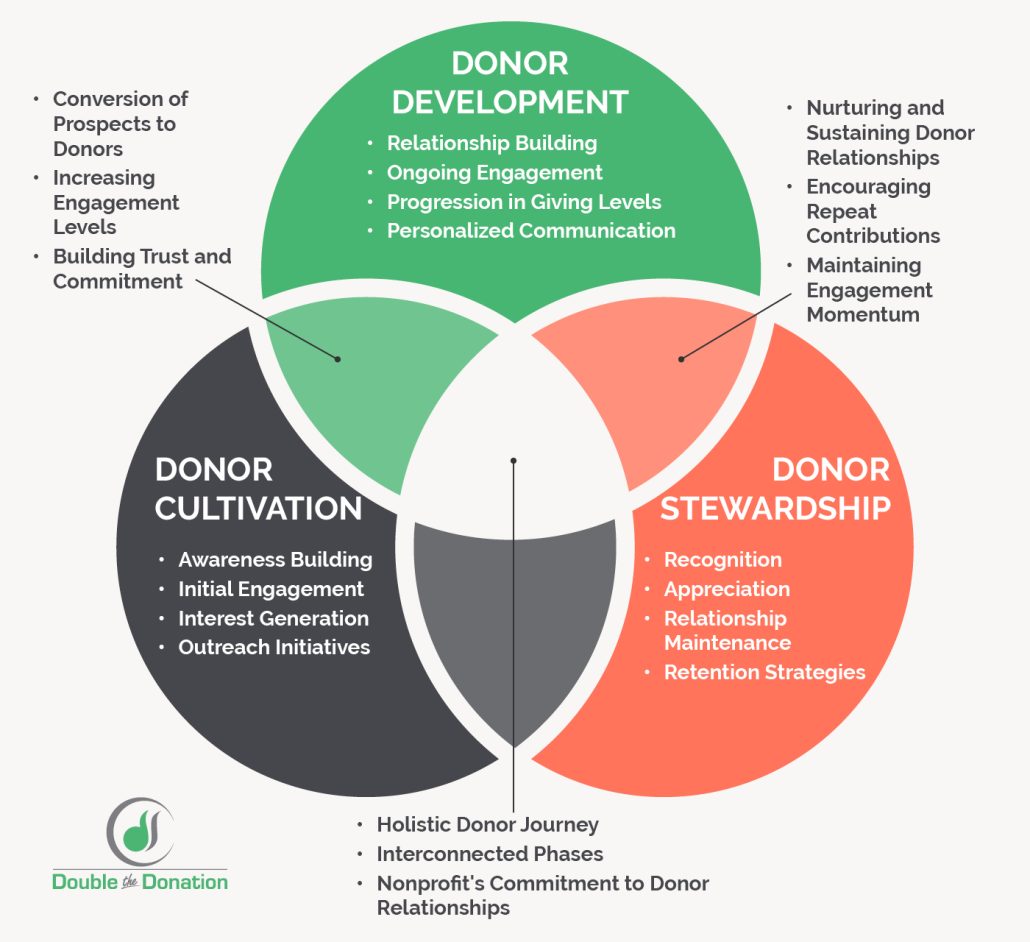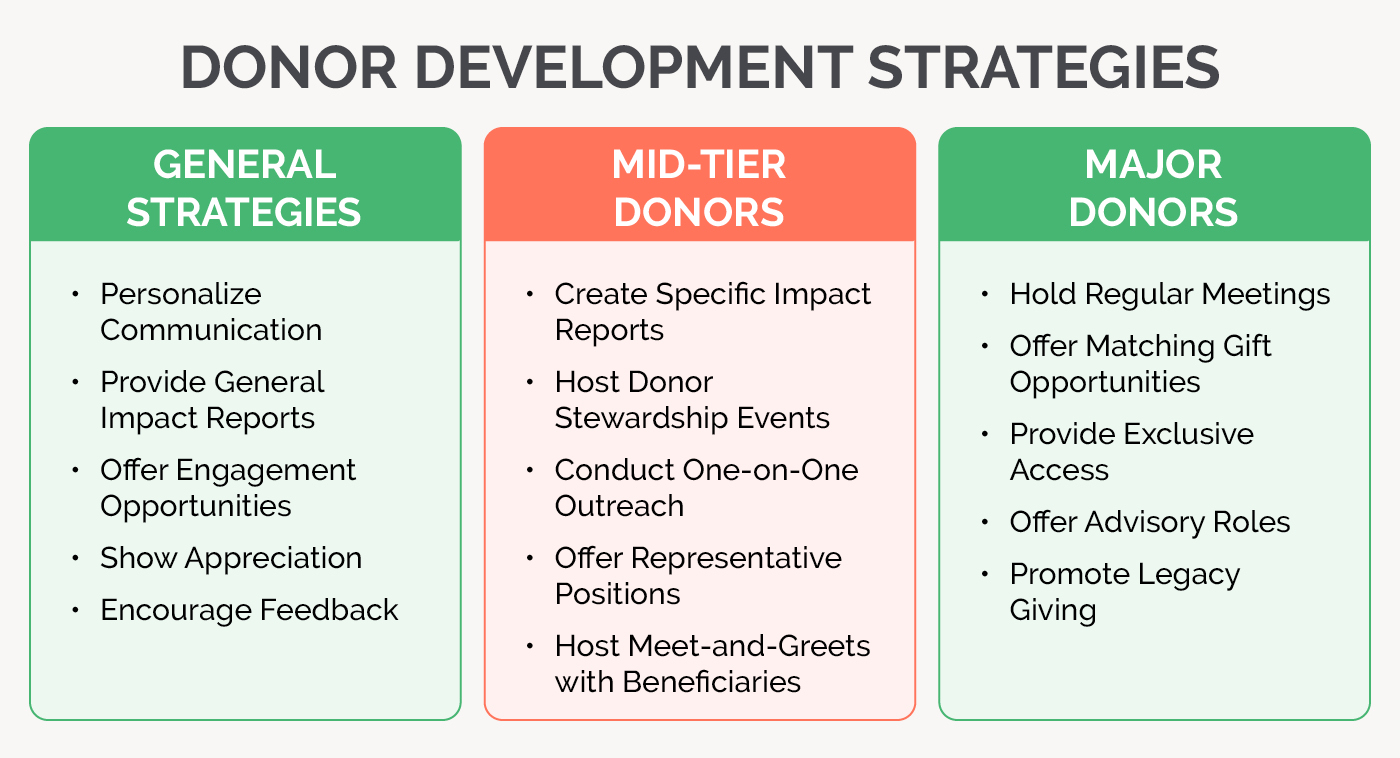Improving Your Donor Development Approach: 15 Expert Tactics
Every nonprofit professional’s dream is to cultivate a donor community full of lifelong supporters. However, achieving this goal requires lots of long-term strategic moves and outreach from your team.
These activities represent donor development, a critical process for nonprofits looking to establish a foothold in their community. Prioritizing donor development can significantly improve your acquisition rate, retention rate, and growth potential.
In this guide, we’ll review the key components of donor development so you can launch your own strategies, including:
Let’s explore the importance of donor development and how you can improve your current approach.
Donor Development: Key Terms to Know
Before we get into the details, let’s define some essential terms you need to know relating to donor development:
- Prospect research is the process of identifying potential donors and gathering information on them that can inform your ask.
- The donor lifecycle refers to the various phases that a donor goes through while supporting your organization. We’ll go into the stages in greater detail later, but generally, the donor lifecycle starts when your nonprofit first makes contact with a potential donor.
- Donor cultivation involves building and cultivating connections with potential donors to persuade them to contribute to your nonprofit.
- Donor stewardship involves maintaining and strengthening existing supporter relationships to secure future gifts.
- Donor development is the overarching approach your nonprofit takes to attract, retain, and upgrade donors. It encompasses donor cultivation and donor stewardship activities.
- Donor retention rate is the percentage of donors that give again after their initial gift instead of churning.
- Legacy commitments refer to planned gifts that donors have pledged for the future through their will or estate plan. These contributions can include bequests, trusts, property, gifts of stock, and more.
Now that you know these important terms, let’s answer some of the questions you might have about donor development.
Donor Development FAQ
Why does donor development matter?
These statistics illustrate the importance of donor development in your nonprofit’s overall financial health and stability:
- It costs about five times more to acquire one new donor than it does to retain an existing one.
- The average repeat donor retention rate for nonprofits is 40%.
- Total giving declined 3.4%—from $516 billion in 2021 to $499 billion in 2022.
As you can see, retention is a more cost-effective way than acquisition to secure revenue from your donor community. And with total giving decreasing, it’s more important than ever to optimize your donor development approach and secure consistent fundraising revenue.
What are the phases of the donor lifecycle?
Understanding the donor lifecycle can help structure your donor development efforts. You can break the donor lifecycle into the following actions and stages:
- The donor makes their initial donation to your nonprofit. The donor learns about your nonprofit and mission via marketing materials or their network. Once they donate, your nonprofit has officially acquired them as a supporter.
- The donor renews their support. Once the donor has been in your community for some time and has decided to donate again, they move into the retention phase.
- If the donor does not give again, they’re considered lapsed, which entails a different re-engagement strategy.
- The donor deepens engagement with your nonprofit. For example, they might join your volunteer program, spearhead a peer-to-peer fundraising campaign on your behalf, or become a public advocate for your cause. These engagements signify that the donor feels a strong connection to your organization, making them a good candidate for a gift upgrade.
- The donor becomes a lifelong advocate for your cause. Once a donor has expanded their involvement with your mission, your team likely knows how to keep them emotionally connected with your nonprofit in the long term.
The goal is to grow your donor’s commitment to your organization over time. That being said, the donor lifecycle looks different for every nonprofit based on your goals, budget, and fundraising capacity. Adjust this general donor lifecycle layout based on your objectives. Throughout the process, track donor engagement in your CRM and tailor your strategy to their preferences.
What’s the difference between donor cultivation, stewardship, and development?
While similar, all of these terms represent a different area of donor relationship management. This Venn diagram can help you understand what these terms commonly encompass and what sets them apart:
| Donor Cultivation | Donor Development | Donor Stewardship | Shared Elements of Donor Cultivation and Donor Development | Shared Elements of Donor Development and Donor Stewardship | Shared Elements of Donor Cultivation, Development, and Stewardship |
|
|
|
|
|
|
All of these terms are important to creating an overall donor development strategy. As we discuss how to plan your own, keep in mind your current activities for each of these processes and how you can improve them.
How can you gauge your current approach to donor development?
Establishing a baseline benchmark for your donor development program improvements is crucial for gauging performance. You can gauge the effectiveness of your current donor development strategies by:
- Mapping your nonprofit’s average donor lifecycle. Consult your CRM to access data about how the average donor’s relationship with your nonprofit would evolve. Then, supplement your quantitative data with qualitative feedback from donors. Survey longtime and new donors to collect additional insight into their journey with your nonprofit. Once you have all relevant data points, create an updated donor lifecycle for your organization and work from there.
- Evaluating your donor segments. Your nonprofit likely segments your donors to conduct personalized outreach, a crucial aspect of donor development. However, as your nonprofit’s donor community changes over time, so should your segmentation approach to accommodate new preferences. For example, you might have received an influx of younger donors in recent years who prefer SMS communications from your nonprofit.
- Establishing key performance indicators (KPIs). Leveraging KPIs is a helpful strategy for standardizing what success means to your nonprofit based on your unique goals. Pertinent KPIs that your nonprofit might track for donor development include cost per dollar raised, retention rate, acquisition rate, and donor lifetime value (the total amount of revenue you can expect to receive from a donor over their entire relationship with your nonprofit).
You’ll need a comprehensive donor database to execute these activities effectively. If your CRM isn’t customizable, scalable, or otherwise doesn’t fit your reporting needs, you should research and implement alternative solutions.
Your job doesn’t end with finding an effective CRM, through! Once you’ve started using a solution that supports your donor development efforts, ensure you implement and stick to data hygiene practices. NPOInfo’s guide to data hygiene for nonprofits recommends adding these activities to your regimen:
- Standardize data formatting.
- Regularly audit and back up your data.
- Invest in data appends.
Improving your data hygiene practices helps you keep your donor development data reliable and useful. This consistency makes it easier to detect and react to data trends, not just during the initial benchmarking phase but continuously over time.
Donor Development: 15 Strategies
General Donor Development Strategies
Implement these tactics into any donor development strategy, no matter how much the donor gives or how long they’ve been with your nonprofit:
- Personalize communication. As previously mentioned, adding a personal touch to your communications is critical for keeping donors engaged with your nonprofit. Besides addressing each message recipient by name, you can boost personalization by sending messages to relevant sections of your supporter base with segmentation.
- Provide impact reports. Your donors want to know that their investment in your mission is making a real difference. Convince them to continue contributing to your nonprofit by creating impact reports that illustrate what fundraising revenue has supported. A common format nonprofits use to convey impact is a public-facing annual report, but you can report impact to donors more frequently via email.
- Offer engagement opportunities. Your donors want to make an impact on your beneficiaries, so offer them the chance to expand their engagement with new opportunities. For example, you might ask an annual donor if they’d like to join your volunteer program to give back differently. Or, you might encourage donors to submit a matching gift request to their employer to multiply their impact.
- Show appreciation. Every donation puts you closer to achieving your mission, no matter its size. Thank all of your donors for their support to show how much they mean to your organization and your beneficiaries. Every donor should receive a thank-you email expressing your team’s heartfelt gratitude and pledging to put their gift to good use.
Encourage feedback. Optimizing the donor development journey is easier with suggestions straight from the segment that you’re trying to optimize. Welcome feedback from donors so you can access new insights that you can use to adjust your strategies. You can collect feedback formally using a survey, or informally by letting donors know that you’re always available if they have ad-hoc suggestions.
Mid-Tier Donor Development Strategies
Mid-tier donors are those who have the potential to upgrade and become lifetime donors. These strategies help you funnel them through more advanced stages of the donor lifecycle:
- Create specific impact reports. Unlike general annual reports, you should break down mid-tier donors’ impact in greater detail. You might make specific impact reports for a donor when they hit a certain milestone, such as an anniversary of supporting your organization or a certain dollar amount crossed.
- Host donor stewardship events. Donor stewardship applies to mid-tier donors because they already have a history of supporting your nonprofit. Host events where you can talk casually with mid-tier donors, such as a luncheon or mixer. This allows you to collect information that can inform your stewardship approach, such as personal milestones and other preferences.
- Conduct one-on-one outreach. Besides inviting them to larger donor stewardship events, engage your mid-tier donors with occasional one-on-one outreach. For instance, you might call them on a special day in their life, such as their birthday or first day of retirement. Casual one-on-one outreach demonstrates that you care about your donors as people, not just a source of money for your cause.
- Offer representative positions. Mid-tier donors have likely been loyal members of your nonprofit’s community for a while. You can foster their investment in your cause by offering them positions as nonprofit representatives. For example, you might start an Ambassador program where mid-tier donors can act as advocates for your nonprofit to their networks and have special responsibilities. This shows them that you view them as a positive contributor to your community and could yield upgraded gifts.
- Host meet-and-greets with beneficiaries. Once your donors reach the mid-tier stage, you should try and deepen their emotional connection with not only your cause but also your beneficiaries themselves. Invite select mid-tier donors to a meet-and-greet event with beneficiaries where they can build unique relationships with them and solidify their commitment to your cause.
Major Donor Development Strategies
Once your donors have entered this stage, they’ve firmly established their loyalty to your nonprofit and have demonstrated a large capacity to give. These tactics can help you secure a significant lifelong commitment from them:
- Hold regular meetings. Major donors should have a greater say in your nonprofit’s activities since they pledge a significant amount to your programs. Organize regular chats with major donors where you can ask for their thoughts about causes that they support. As long as you clarify that your team has the final say, this can be a beneficial opportunity for both you and your major donors to shape your daily operations.
- Offer matching gift opportunities. If your major donors are looking for ways to expand their impact on your fundraising efforts, pitch a matching gift drive to them. In a matching gift drive, the major donor will pledge a matched contribution of whatever individual donors contribute up to a certain amount. For instance, a major donor could pledge to match all gifts up to the $10,000 benchmark. This not only gives the major donor a creative way to give back but also encourages other people to contribute.
- Provide exclusive access. Make your fundraising events and programs even more interesting for major donors by offering exclusive perks. For example, you might offer them a VIP table at your charity auction or invite them to shadow your programming in progress. Just remember to secure permission from your beneficiaries first if you want to show major donors a beneficiary-facing activity.
- Offer advisory roles. Whether it’s a position on your Board of Directors or a turn as the head of your Ambassador program, your major donors will likely appreciate new ways to get involved. If you have many major donors who are interested or if the role makes significant decisions for the nonprofit, host interviews to make sure they’re suited for the job. Also, remember to communicate the time commitment for the role before they start so they can adjust their schedule accordingly.
- Promote legacy giving. This truly unique giving opportunity allows donors to continue supporting your nonprofit even after they’ve passed away. With a planned giving program, your major donors can pledge money from their estate to your organization. Planned giving can be highly personal and sensitive, which is why it’s best to pitch to major donors who are already comfortable with your team and who are extremely passionate about your mission.
Wrapping Up + Additional Resources
While implementing these suggestions provides a foundation for your donor development, you should customize your tactics based on your community and strategic plan. As long as you take the approaches that best suit your donors’ needs and provide creative ways to give back, you can boost your donors’ lifetime value and cultivate an ideal donor lifecycle for your nonprofit.
- How to Market Matching Gifts: The Comprehensive FAQ Guide. Matching gifts is an easy and effective way to give that can deepen your relationships with donors. Here’s how to market them to make a big impact.
- How to Make Every Word Count in A Donation Thank You Letter. Learn how to turn donor thank-you letters into a retention tool with this guide.
- 9 Donor Engagement Strategies to Transform Your Outreach. Engaging donors allows your supporter base to feel more like a community. These tips can help you launch your own efforts.
